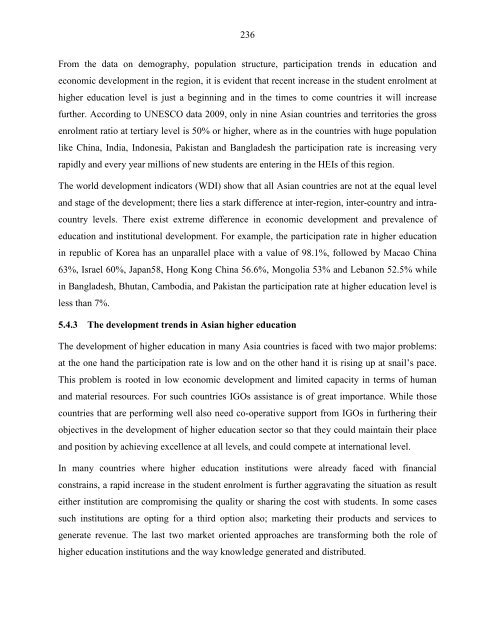Higher education in Asian countries and the role of international ...
Higher education in Asian countries and the role of international ...
Higher education in Asian countries and the role of international ...
Create successful ePaper yourself
Turn your PDF publications into a flip-book with our unique Google optimized e-Paper software.
236<br />
From <strong>the</strong> data on demography, population structure, participation trends <strong>in</strong> <strong>education</strong> <strong>and</strong><br />
economic development <strong>in</strong> <strong>the</strong> region, it is evident that recent <strong>in</strong>crease <strong>in</strong> <strong>the</strong> student enrolment at<br />
higher <strong>education</strong> level is just a beg<strong>in</strong>n<strong>in</strong>g <strong>and</strong> <strong>in</strong> <strong>the</strong> times to come <strong>countries</strong> it will <strong>in</strong>crease<br />
fur<strong>the</strong>r. Accord<strong>in</strong>g to UNESCO data 2009, only <strong>in</strong> n<strong>in</strong>e <strong>Asian</strong> <strong>countries</strong> <strong>and</strong> territories <strong>the</strong> gross<br />
enrolment ratio at tertiary level is 50% or higher, where as <strong>in</strong> <strong>the</strong> <strong>countries</strong> with huge population<br />
like Ch<strong>in</strong>a, India, Indonesia, Pakistan <strong>and</strong> Bangladesh <strong>the</strong> participation rate is <strong>in</strong>creas<strong>in</strong>g very<br />
rapidly <strong>and</strong> every year millions <strong>of</strong> new students are enter<strong>in</strong>g <strong>in</strong> <strong>the</strong> HEIs <strong>of</strong> this region.<br />
The world development <strong>in</strong>dicators (WDI) show that all <strong>Asian</strong> <strong>countries</strong> are not at <strong>the</strong> equal level<br />
<strong>and</strong> stage <strong>of</strong> <strong>the</strong> development; <strong>the</strong>re lies a stark difference at <strong>in</strong>ter-region, <strong>in</strong>ter-country <strong>and</strong> <strong>in</strong>tra-<br />
country levels. There exist extreme difference <strong>in</strong> economic development <strong>and</strong> prevalence <strong>of</strong><br />
<strong>education</strong> <strong>and</strong> <strong>in</strong>stitutional development. For example, <strong>the</strong> participation rate <strong>in</strong> higher <strong>education</strong><br />
<strong>in</strong> republic <strong>of</strong> Korea has an unparallel place with a value <strong>of</strong> 98.1%, followed by Macao Ch<strong>in</strong>a<br />
63%, Israel 60%, Japan58, Hong Kong Ch<strong>in</strong>a 56.6%, Mongolia 53% <strong>and</strong> Lebanon 52.5% while<br />
<strong>in</strong> Bangladesh, Bhutan, Cambodia, <strong>and</strong> Pakistan <strong>the</strong> participation rate at higher <strong>education</strong> level is<br />
less than 7%.<br />
5.4.3 The development trends <strong>in</strong> <strong>Asian</strong> higher <strong>education</strong><br />
The development <strong>of</strong> higher <strong>education</strong> <strong>in</strong> many Asia <strong>countries</strong> is faced with two major problems:<br />
at <strong>the</strong> one h<strong>and</strong> <strong>the</strong> participation rate is low <strong>and</strong> on <strong>the</strong> o<strong>the</strong>r h<strong>and</strong> it is ris<strong>in</strong>g up at snail‟s pace.<br />
This problem is rooted <strong>in</strong> low economic development <strong>and</strong> limited capacity <strong>in</strong> terms <strong>of</strong> human<br />
<strong>and</strong> material resources. For such <strong>countries</strong> IGOs assistance is <strong>of</strong> great importance. While those<br />
<strong>countries</strong> that are perform<strong>in</strong>g well also need co-operative support from IGOs <strong>in</strong> fur<strong>the</strong>r<strong>in</strong>g <strong>the</strong>ir<br />
objectives <strong>in</strong> <strong>the</strong> development <strong>of</strong> higher <strong>education</strong> sector so that <strong>the</strong>y could ma<strong>in</strong>ta<strong>in</strong> <strong>the</strong>ir place<br />
<strong>and</strong> position by achiev<strong>in</strong>g excellence at all levels, <strong>and</strong> could compete at <strong>in</strong>ternational level.<br />
In many <strong>countries</strong> where higher <strong>education</strong> <strong>in</strong>stitutions were already faced with f<strong>in</strong>ancial<br />
constra<strong>in</strong>s, a rapid <strong>in</strong>crease <strong>in</strong> <strong>the</strong> student enrolment is fur<strong>the</strong>r aggravat<strong>in</strong>g <strong>the</strong> situation as result<br />
ei<strong>the</strong>r <strong>in</strong>stitution are compromis<strong>in</strong>g <strong>the</strong> quality or shar<strong>in</strong>g <strong>the</strong> cost with students. In some cases<br />
such <strong>in</strong>stitutions are opt<strong>in</strong>g for a third option also; market<strong>in</strong>g <strong>the</strong>ir products <strong>and</strong> services to<br />
generate revenue. The last two market oriented approaches are transform<strong>in</strong>g both <strong>the</strong> <strong>role</strong> <strong>of</strong><br />
higher <strong>education</strong> <strong>in</strong>stitutions <strong>and</strong> <strong>the</strong> way knowledge generated <strong>and</strong> distributed.

















